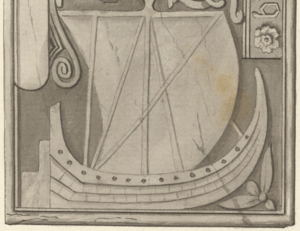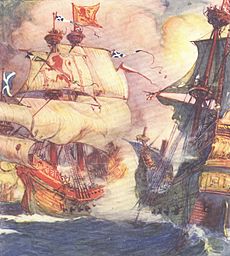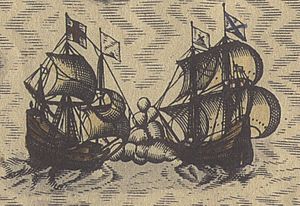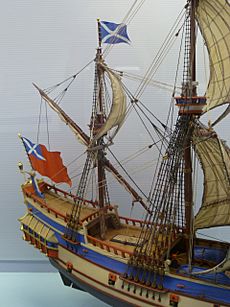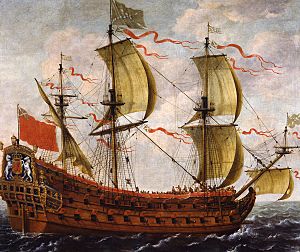Royal Scots Navy facts for kids
Quick facts for kids Royal Scots NavyRoyal Scots Navy (RSN) |
|
|---|---|
| Cabhlach Rìoghail na h-Alba | |
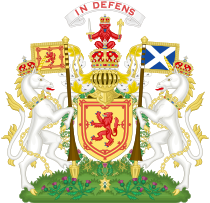
Royal Arms of Scotland (1603–1707)
|
|
| Active | Middle Ages – 1707 |
| Country | |
| Allegiance | Monarch of Scotland |
| Type | Navy |
| Role | Coastal defence |
| Part of | Scottish Military |
| Motto(s) | In My Defens God Me Defend ("In My Defence God Me Defend") |
| Colours | Blue, White, & Red |
| Engagements | |
| Disbanded | 1 May 1707 |
| Commanders | |
| Lord High Admiral | David Wemyss (last) |
| Insignia | |
| Civil Ensign | 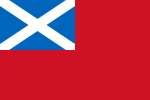 |
The Royal Scots Navy (also known as the Old Scots Navy) was the official navy of the Kingdom of Scotland. It existed from the Middle Ages until 1707. In 1707, Scotland joined with England to form Great Britain. At that time, the Scottish Navy merged with England's Royal Navy.
Records show that Scottish kings commanded fleets as early as the 1100s and 1200s. King Robert I (also known as Robert the Bruce) made the navy stronger. He used it to fight the English during the Scottish Wars of Independence (1296–1328). After Scotland became independent, its naval power continued to grow.
In the late 1300s, Scotland often hired merchant ships and privateers to fight England. These ships came from Scotland, Flanders, and France. King James I (1406–1437) became very interested in naval power. He set up a shipbuilding yard in Leith and likely created the important job of Lord High Admiral of Scotland.
King James IV (1488–1513) greatly improved the navy. He built a new harbor at Newhaven and a dockyard at the Pools of Airth. He owned 38 ships, including the Great Michael. This was the largest ship in Europe at the time. Scottish ships fought well against privateers. They also helped the king on his trips to the islands and in wars in Scandinavia and the Baltic Sea. However, most of these ships were sold after the Battle of Flodden in 1513.
After this, Scotland's navy mostly relied on privateers and hired merchant ships again. A privateer was a private ship authorized by the government to attack enemy ships. Even with truces, there were often small naval battles with England. King James V built a new harbor at Burntisland in 1542. His navy mainly explored the Scottish Isles and traveled to France.
When Scotland and England joined under one king in 1603, their conflicts ended. But Scottish merchant ships then faced attacks from privateers because Scotland was involved in England's foreign wars. In 1626, Scotland bought three ships to protect its trade. Many privateers also joined the fight. In 1627, the Royal Scots Navy and privateers helped England in a big battle in the Bay of Biscay. Scottish ships also sailed to the West Indies and helped capture Quebec in 1629.
After the English Civil War, a "Scotch Guard" was formed to protect Scotland's coast. This force mostly used English ships but had Scottish money and sailors. It slowly became more Scottish. However, Oliver Cromwell's navy defeated the Scottish forces. When Scotland became part of the Commonwealth in 1653, its navy joined the Commonwealth navy.
After the monarchy was restored in 1660, Scottish sailors were protected from being forced into service. But Scottish towns still had to provide a certain number of sailors for the English Royal Navy. English Royal Navy ships also started patrolling Scottish waters. In the Second Anglo-Dutch War (1665–1667) and Third Anglo-Dutch War (1672–1674), many Scottish privateers helped in the naval battles.
In the 1690s, Scottish merchants created a small fleet of five ships for the Darien scheme. This was a plan to start a Scottish colony in America. In 1696, a professional navy of three warships was also created to protect local shipping. After the Act of Union in 1707, these ships and their crews became part of the British Royal Navy.
Contents
By the late Middle Ages, Scotland had two main types of naval traditions. In the west, there was a tradition of galley warfare. This came from the Viking sea-based lords in the Highlands and Islands. These ships were similar to the Viking long-ship. Longships were fast, light wooden boats with a shallow bottom. This design allowed them to sail in shallow waters and land easily on beaches. They could also reverse direction quickly.
Over time, the longship was replaced by ships like the birlinn, highland galley, and lymphad. These ships were built with overlapping planks and usually had a mast with sails. They also had oars for rowing. Like the longships, they had high front and back ends. They were still light enough to be pulled over land. From the late 1100s, they started using a rudder at the back for steering. The MacDonald Lord of the Isles were a major naval power in the Highlands and Islands. They often acted like independent kings and could gather large fleets.
Records from the Middle Ages mention fleets commanded by Scottish kings. These include William the Lion and Alexander II. Alexander II personally led a large naval force in 1249. He planned to attack the Kingdom of the Isles, but he died before the campaign began.
Viking naval power weakened due to conflicts among Scandinavian kingdoms. But it grew strong again in the 1200s. Norwegian kings built some of the largest ships in Northern Europe. In 1263, King Hakon Hakonsson led a fleet of 40 ships to the Scottish islands. Local allies joined him, making the fleet as large as 200 ships. King Alexander III had several large oared ships built. However, he avoided a sea battle. After a land defeat at the Battle of Largs and winter storms, the Norwegian fleet went home. This made the Scottish crown the main power in the region. The Western Isles were given to Alexander in 1266.
English naval power was very important for King Edward I's campaigns in Scotland from 1296. He used merchant ships from England, Ireland, and his allies to transport and supply his armies. King Robert I's success was partly due to his ability to use naval forces from the Islands. He also gained support from a major naval power in the North Sea. This naval strength helped Robert defeat English attempts to capture him. It also allowed him to blockade English fortresses like Perth and Stirling. The blockade of Stirling led to the English defeat at Bannockburn in 1314. Scottish naval forces also helped invade the Isle of Man and Ireland. They were also key in the blockade of Berwick, which fell in 1318.
After Scotland became independent, King Robert I focused on building up its naval strength. This was mainly on the west coast. Records show that his vassals in that area had to provide ships and crews. Near the end of his reign, he oversaw the building of at least one royal warship. This ship was built near his palace at Cardross.
In the late 1300s, naval warfare with England was mostly carried out by hired Scottish, Flemish, and French merchant ships and privateers. King James I of Scotland (1406–1437) became more interested in naval power. After he returned to Scotland in 1424, he set up a shipbuilding yard at Leith. He also built a marine storehouse and a workshop. Royal ships were built there for both trade and war. One of these ships went with him on his trip to the Islands in 1429. The job of Lord High Admiral of Scotland was probably created around this time. This job later became hereditary, meaning it passed down through families.
King James II (1437–1460) bought a caravel ship by 1449. Around 1476, a Scottish merchant named John Barton received letters of marque. These allowed him to capture Portuguese ships to make up for his own ships being captured. His three sons, John, Andrew, and Robert, continued this practice. They played a big part in Scotland's naval efforts in the 1500s.
In 1488, King James III (1451–88) got help from his two warships, Flower and King's Carvel (also known as Yellow Carvel). These were commanded by Andrew Wood of Largo. After the king's death, Wood served his son, James IV (1488–1513). Wood defeated an English attack on the Forth in 1489. He also defeated three more English ships near the mouth of the River Tay the next year.
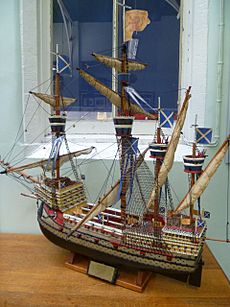
King James IV greatly improved the navy. In May 1504, he founded a harbor at Newhaven. Two years later, he ordered a dockyard to be built at the Pools of Airth. New forts on Inchgarvie protected the upper parts of the Forth River. Scottish ships successfully fought privateers. They also joined the king on his trips to the islands. They even helped in conflicts in Scandinavia and the Baltic Sea.
In 1504, the king went with a squadron of ships under Andrew Wood. These ships had heavy artillery. They used their cannons to attack and defeat the strongholds of the MacDonald Lord of the Isles. Since some island forts could only be attacked from the sea, this may have changed naval warfare. It brought in a new era of using cannons on ships.
In 1509, timber was cut for the king's ships. James IV acquired 38 ships for the Royal Scottish Navy. These included the Margaret and the large ship Michael. The Great Michael was built at Newhaven and launched in 1511. It was 240 feet long and weighed 1,000 tons. It had 24 cannons and was the largest ship in Europe at that time. This ship was designed specifically to carry heavy artillery.
For the Battle of Flodden campaign, the Scottish fleet had 16 large and 10 smaller ships. After attacking Carrickfergus in Ireland, the fleet joined the French. However, it did not have much impact on the war. After the terrible defeat at Flodden, the Great Michael and possibly other ships were sold to the French. Royal records stopped mentioning the king's ships after 1516. During the time James V was too young to rule, Scotland's naval efforts again depended on privateers and hired merchant ships.
In the war of 1521–26, Scotland and England were on opposite sides. Scotland had six warships attacking English and Imperial ships. They blockaded the Humber River in 1523. Although Scottish captains like Robert Barton captured enemy ships, the naval campaign was not very successful.
Scottish Privateers
Scottish privateers and pirates attacked ships in the North Sea and off the French Atlantic coast. Scotland's Admiralty court decided if a captured ship was a legal prize. It also handled getting goods back. The court received a tenth of the value of a prize, making it a profitable business for the admiral.
The privateers Andrew and Robert Barton were still using their special permits against the Portuguese in 1561. The Bartons operated along the east coast of Britain. Other privateers used French ports like Rouen, Dieppe, or Brest as their bases. In 1507, Robert Barton, with his ship Lion, captured a Portuguese ship. But he was arrested by Dutch authorities for piracy. James IV managed to get him released.
In 1509, John Barton, also with Lion, captured another Portuguese ship. This ship was carrying both Portuguese and English goods. In 1511, Andrew Barton sailed south to continue the private war. He captured ships he claimed were Portuguese, but they had English goods. He was stopped by English commanders Lord Thomas Howard and Sir Edward Howard. Barton was killed, and his two ships were captured and given to the English navy.
James V became king in his own right in 1524. He was not as interested in building a navy as his father had been. He relied on ships given by France, like the Salamander, or captured ships, like the English Mary Willoughby. Scotland's shipbuilding mostly focused on small boats and repairs. It fell behind countries like the Netherlands, which were becoming leaders in shipbuilding.
Even with truces between England and Scotland, small naval battles often broke out in the 1530s. At least four of Scotland's six known warships were royal naval vessels. In 1542, James V built a new harbor at Burntisland. It was called 'Our Lady Port' or 'New Haven'. In 1544, it was described as having three forts with guns and a pier for large ships.
The main use of naval power during James V's reign was for trips to the Scottish Isles and France. In 1536, the king sailed around the Isles. Later that year, he sailed from Kirkcaldy with six ships, including the 600-ton Mary Willoughby. He arrived in Dieppe to meet his first wife, Madeleine of Valois. After his marriage, he sailed back to Leith with four large Scottish ships and ten French ones.
After Queen Madeleine died, John Barton, in the Salamander, returned to France in 1538. He picked up the new queen, Mary of Guise, with the ships Moriset and Mary Willoughby. In 1538, James V boarded the newly equipped Salamander at Leith. Accompanied by Mary Willoughby, Great Unicorn, Little Unicorn, Lion, and twelve other ships, he sailed to Kirkwall in Orkney. Then he went to Lewis in the West. He might have used new maps from his first voyage.
The Rough Wooing Conflicts

The "Rough Wooing" was an attempt by England to force a marriage between James V's daughter, Mary, Queen of Scots, and Henry VIII's son, Edward VI. In 1542, Mary Willoughby, Lion, and Salamander, led by John Barton, attacked merchants and fishermen off Whitby. They later trapped an English merchant ship in a creek in Brittany. In 1544, Edinburgh was attacked by an English naval force and burned. Salamander and the Scottish-built Unicorn were captured at Leith. Scotland still had two royal naval vessels and many smaller private ships.
When Charles V declared war on Scotland in 1544, Scotland began a very profitable privateering campaign. This lasted six years. The money gained from this likely made up for losses in trade. In March 1547, the Great Lion was captured off Dover by Sir Andrew Dudley. In April 1547, Mary Willoughby and Great Spaniard were blockading Dieppe and Le Havre. Mary Willoughby was recaptured by Lord Hertford.
In 1547, Edward Clinton's invasion fleet of 60 ships, including 35 warships, supported the English advance into Scotland. The English fleet's strength was clear when The Mary Willoughby, along with Bosse and an English prize, were recaptured without a fight near Blackness. In these campaigns, Scotland lost all four of its royal ships. They had to rely on privateers until a new royal fleet was created in the 1620s.
However, as the English fleet left for winter, the remaining Scottish ships began to pick off stray or careless English merchant ships. In June 1548, the situation changed when a French squadron arrived. It had three warships, 16 galleys, and ships carrying 6,000 men. The English lost a ship in a fight with the French galleys. The situation for the English worsened on land and sea. The Treaty of Boulogne (1550) ended the Rough Wooing. This period led to France having a strong influence over Scottish affairs.
Scottish ships operated in the West Indies from the 1540s. They joined the French in capturing Burburuta in 1567. Naval warfare and privateering between England and Scotland happened on and off in the 1550s. When relations between England and Scotland worsened again in 1557, small ships called 'shallops' were seen between Leith and France. They pretended to be fishing boats but carried weapons and money. Private merchant ships were armed at Leith, Aberdeen, and Dundee. The regent, Mary of Guise, claimed English ships as prizes for her fleet. One of these was over 200 tons.
In August 1557, the refitted Mary Willoughby sailed with 11 other ships against Scotland. They landed troops and six cannons on Orkney. They attacked Kirkwall Castle, St Magnus Cathedral, and the Bishop's Palace. A Scottish force of 3,000 men pushed back the English. The English vice-admiral, Sir John Clere, was killed. But none of the English ships were lost. In July 1558, two Scottish warships from Aberdeen, the Meikle Swallow and Little Swallow, attacked an English fleet off Shetland. The Scottish sailors took cattle and other goods from Olave Sinclair on Mousa. Sinclair later asked for payment in the Edinburgh courts.
The Reformation Crisis
When the Protestant Elizabeth I became Queen of England in 1558, English and Scottish Protestants found themselves on the same side. The Scottish Protestants asked England for military help to remove the French. In 1559, English captain William Winter sailed north with 34 ships. He scattered and captured the Scottish and French fleets. This led to the siege of the French forces in Leith. Eventually, the French left Scotland, and the Protestant Lords of the Congregation took control. Scottish and English interests aligned, and naval conflicts decreased.
The Marian Civil War
After Mary, Queen of Scots was captured at the battle of Carberry Hill, the Earl of Bothwell escaped by ship to Shetland. In August 1567, the Privy Council sent William Kirkcaldy of Grange and William Murray of Tullibardine to chase him. Some of their ships came from Dundee, including James, Primrose, and Robert. They found Bothwell near Lerwick. Four of Bothwell's ships sailed north to Unst, where he was trying to hire more ships. Kirkcaldy's main ship, Lion, chased one of Bothwell's ships. Both ships were damaged on a hidden rock. Bothwell sent his treasure ship to Scalloway. He then fought a three-hour sea battle off the Port of Unst. The mast of one of Bothwell's ships was shot away. A storm then forced him to sail towards Norway.
In April 1573, Mary's supporters held Edinburgh Castle, continuing the civil war. Cannons from Stirling Castle were brought to Leith in four boats. Regent Morton hired two ships in Leith with their captains and 80 men for eight days. These ships sailed to Berwick upon Tweed to meet and escort English ships. These English ships were carrying cannons to bombard Edinburgh Castle.
King James VI's Trip to Denmark
King James VI hired ships for his ambassadors and other uses. In 1588, the James Royall from Ayr was prepared for Sir William Stewart. He used it to chase the rebel Lord Maxwell with 120 musketeers. In October 1589, James VI decided to sail to Norway to meet his future wife, Anne of Denmark. His courtiers, led by John Maitland, prepared a fleet of six ships. Patrick Vans of Barnbarroch hired a small ship called Falcon of Leith.
Maitland's records show the costs of preparing the James Royall. It was equipped with cannons by John Chisholm, the officer in charge of weapons. The cannons were probably for firing salutes. The sails of the James were decorated with red fabric. James VI sent a man named Robert Dog from Denmark to Lübeck to buy gunpowder. He shipped it to Edinburgh Castle. James VI also sent orders from Denmark to the town of Edinburgh. He asked the council to hire a ship for his return. They chose the Angel of Kirkcaldy. This ship was painted by James Warkman. When Captain Robert Jameson died in January 1608, the James was at Ayr, without its rigging or furnishings.
Royal and Privateer Fleets
After Scotland and England joined under one king in 1603, conflicts between them ended. However, Scotland became involved in England's foreign policy. This meant Scottish merchant ships were now open to attack. In the 1620s, Scotland fought as England's ally, first against Spain and then against France. Scotland also had duties in the North Sea during the Danish involvement in the Thirty Years' War.
In 1626, Scotland bought and equipped three ships for at least £5,200. These ships were to guard against privateers from Spanish-controlled Dunkirk. Other ships were also armed. The acting High Admiral, John Gordon of Lochinvar, organized up to three fleets of privateers. One of Lochinvar's privateer fleets was likely sent to help the English Royal Navy protect Irish waters in 1626.
In 1627, the Royal Scots Navy and privateers from towns took part in a major expedition to Biscay. Scottish ships also returned to the West Indies. Lochinvar captured French ships and established the Scottish colony of Charles Island. In 1629, two privateer fleets, led by Lochinvar and William Lord Alexander, sailed to Canada. They helped capture Quebec from the French. Quebec was later returned after peace was made.
During the Bishops' Wars (1639–40), the king tried to blockade Scotland. He wanted to stop trade and prevent troops from returning from Europe. The king planned attacks from England on the East coast and from Ireland on the West. But these attacks did not happen. Scottish privateers captured several English ships. The Covenanters, who supported the Scottish church, planned to equip Dutch ships with Scottish and Dutch crews to join the naval war.
After the Covenanters allied with the English Parliament, they set up two patrol fleets. These were for the Atlantic and North Sea coasts and were called the "Scotch Guard." These patrols protected against Royalist attempts to move men, money, and weapons. They also guarded against raids on Scottish shipping, especially from the Irish Confederate fleet and Royalist forces at Dunkirk. These patrols mainly used small English warships. They were controlled by the Navy Commissioners in London. However, they relied heavily on Scottish officers and money. After 1646, the West Coast fleet became much more Scottish.
The Scottish navy was easily defeated by the English fleet that came with Oliver Cromwell's army. Cromwell conquered Scotland in 1649–51. After his victory, the Scottish ships and crews were divided among the Commonwealth fleet.
Although Scottish sailors were protected from being forced into service by Charles II, a set number of sailors were still taken from coastal towns for the Royal Navy. This happened during the second half of the 1600s. Royal Navy ships now patrolled Scottish waters even during peacetime. For example, the small warship HMS Kingfisher attacked Carrick Castle during the Earl of Argyll's rebellion in 1685.
Scotland fought against the Dutch and their allies in the Second Anglo-Dutch War (1665–67) and Third Anglo-Dutch Wars (1672–74) as an independent kingdom. A very large number of Scottish captains, perhaps as many as 80 to 120, received letters of marque. Privateers played a major role in the naval conflicts of these wars.
By 1697, the English Royal Navy had 323 warships. Scotland, however, still relied on merchant ships and privateers. In the 1690s, two different plans for larger naval forces began. As usual, merchants played a bigger part than the government. The first was the Darien Scheme. This was a plan to create a Scottish colony in Spanish-controlled America. The Company of Scotland created a fleet of five ships for this, including Caledonia and St. Andrew. All were built or rented in Holland and Hamburg. The fleet sailed to the Isthmus of Darien in 1698, but the plan failed, and only one ship returned to Scotland.
At the same time, it was decided to create a professional navy. This navy would protect trade in home waters during the Nine Years' War (1688–97) with France. Three warships were bought from English shipbuilders in 1696. These were Royal William, a 32-gun ship, and two smaller ships, Royal Mary and Dumbarton Castle, each with 24 guns. These were generally called frigates.
After the Act of Union in 1707, the Scottish Navy merged with England's navy. The job of Lord High Admiral became part of the Admiral of Great Britain. The three ships of the small Royal Scottish Navy were transferred to the Royal Navy. Some Scottish officers later left the Royal Navy to serve in the new Russian navy of Peter the Great. These included Captain Thomas Gordon of the Royal Mary. He became a commodore in 1717 and rose to be an Admiral and commander-in-chief of the Baltic Fleet.
Notable Officers
- John Bosswell
- John Brown
- Thomas Gordon
- Andrew Wood of Largo
- Andrew Barton
- Robert Barton of Over Barnton
See also
- List of warships of the Scots Navy
- Royal Navy (disambiguation)


